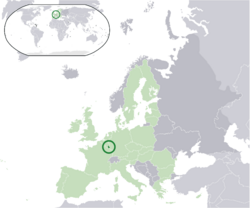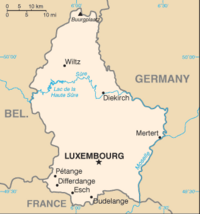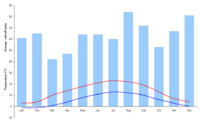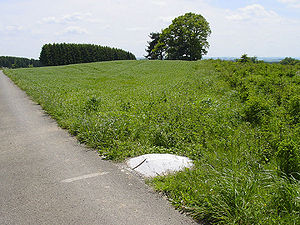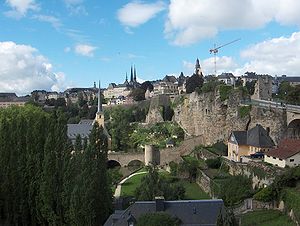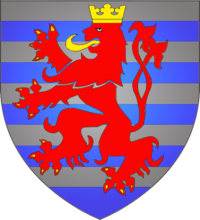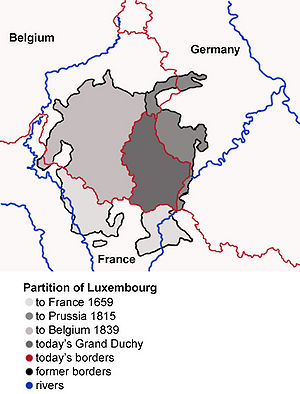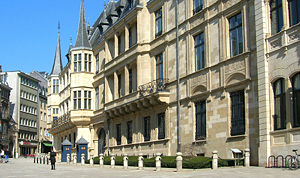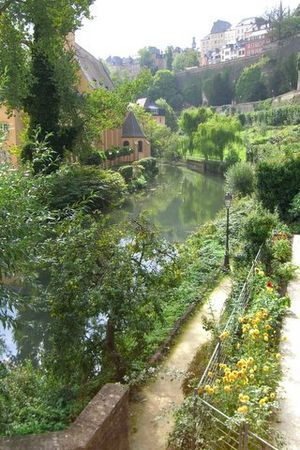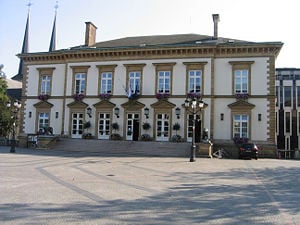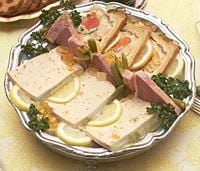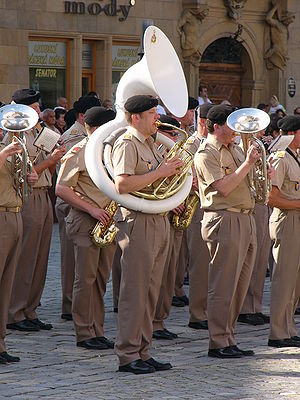Luxembourg
| Groussherzogtum Lëtzebuerg Grand-Duché de Luxembourg Großherzogtum Luxemburg Grand Duchy of Luxembourg |
||||||
|---|---|---|---|---|---|---|
|
||||||
| Motto: "Mir wëlle bleiwe wat mir sinn" (Luxembourgish) "We wish to remain what we are" |
||||||
| Anthem: Ons Hémécht "Our Homeland" Royal anthem: De Wilhelmus 1 |
||||||
| Capital (and largest city) | Luxembourg 49°36′N 6°7′E | |||||
| Official languages | French, German, Luxembourgish (de jure since 1984) |
|||||
| Demonym | Luxembourger(s) | |||||
| Government | Constitutional grand duchy | |||||
| - | Grand Duke | Grand Duke Henri (List) | ||||
| - | Prime minister | Jean-Claude Juncker (List) | ||||
| History | ||||||
| - | Independence | 9 June 1815 | ||||
| - | 1st Treaty of London | 19 April 1839 | ||||
| - | 2nd Treaty of London | 11 May 1867 | ||||
| - | End of personal union | 23 November 1890 | ||||
| EU accession | March 25 1957 | |||||
| Area | ||||||
| - | Total | 2,586.4 km² (176th) 999 sq mi |
||||
| - | Water (%) | negligible | ||||
| Population | ||||||
| - | 2007 estimate | 480,222 (171st) | ||||
| - | 2001 census | 439,539 | ||||
| GDP (PPP) | 2006 estimate | |||||
| - | Total | $32.6 billion (97th) | ||||
| - | Per capita | $71,400 (2006) (1st) | ||||
| GDP (nominal) | 2006 estimate | |||||
| - | Total | $40.577 billion (65th) | ||||
| - | Per capita | $87,995 (1st) | ||||
| Currency | Euro (€)2 (EUR) |
|||||
| Time zone | CET (UTC+1) | |||||
| - | Summer (DST) | CEST (UTC+2) | ||||
| Internet TLD | .lu3 | |||||
| Calling code | +352 | |||||
| 1 | Not the same as the Het Wilhelmus of the Netherlands. | |||||
| 2 | Prior to 1999: Luxembourgian franc. | |||||
| 3 | The .eu domain is also used, as it is shared with other European Union member states. | |||||
The Grand Duchy of Luxembourg (Luxembourgish: Groussherzogtum Lëtzebuerg, French: Grand-Duché de Luxembourg, German: Großherzogtum Luxemburg), archaically spelled Luxemburg, is a small landlocked country in western Europe, bordered by Belgium, France, and Germany.
The world's only sovereign Grand Duchy, Luxembourg is a parliamentary representative democracy with a constitutional monarchy, ruled by a Grand Duke.
Luxembourg lies on the cultural divide between Romance Europe and Germanic Europe, borrowing customs from each of the distinct traditions. Although a secular state, Luxembourg is predominantly Roman Catholic.
The country has a highly developed economy, with the highest Gross Domestic Product per capita in the world. For many people in other parts of Europe, Luxembourg is best known for its radio and television stations, Radio Luxembourg and RTL.
Geography
Luxembourg is one of the smallest countries in Europe, and ranked 175th in size of all the 194 independent countries of the world; the country is about 999 square miles (2586 square kilometers) in size, and measures 51 miles long (82km) and 35 miles (57km) wide. It is slightly smaller than Rhode Island in the United States.
To the east, Luxembourg borders the German states of Rhineland-Palatinate and Saarland, and, to the south, it borders the French région of Lorraine. The Grand Duchy borders the Belgian Walloon Region, in particular the latter's provinces of Luxembourg and Liège to the west and to the north respectively.
The northern third of the country is known as the ''Oesling'', and forms part of the Ardennes. It is dominated by hills and low mountains, including the Kneiff, which is the highest point, at 1837 feet (560 meters).
The southern two-thirds of the country is called the ''Gutland'', and is more densely populated than the Oesling. It is also more diverse, and can be divided into five geographic sub-regions. The Luxembourg plateau, in south-central Luxembourg, is a large, flat, sandstone formation, and the site of the city of Luxembourg. Little Switzerland, in the east of Luxembourg, has craggy terrain and thick forests. The Moselle valley is the lowest-lying region, running along the south-eastern border. The Red Lands, in the far south and southwest, are Luxembourg's industrial heartland and home to many of Luxembourg's largest towns.
The border between Luxembourg and Germany is formed by three rivers: the Moselle, the Sauer, and the Our. Other major rivers are the Alzette, the Attert, the Clerve, and the Wiltz. The valleys of the mid-Sauer and Attert form the border between the Gutland and the Oesling.
The Upper Sûre lake is the largest stretch of water in the Grandy Duchy. Surrounded by luxuriant vegetation and peaceful creeks, the lake is a centre for water sports, such as sailing, canoeing, and kayaking. Such outdoor activities, which has made it an attractive spot for tourists, have led to the growth of a local crafts industry.
The town of Esch-sur-Sûre nestles at one end of the lake. Immediately above it, the river has been dammed to form a hydroelectric reservoir extending some six miles (10km) up the valley. The Upper Sûre dam was built in the 1960s to meet the country's drinking water requirements.
Luxembourg is part of the West European Continental climatic region, and enjoys a temperate climate without extremes. Winters are mild, summers fairly cool, and rainfall is high. Rainfall reaches 49 inches (1.2 meters) a year in some areas. In the summer, excessive heat is rare and temperatures drop noticeably at night. Low temperatures and humidity make for what those living in this part of the country call, optimistically, an "invigorating climate".
Luxembourg's flora is characterized by the country's location at the border between the Atlantic-European and Central-European climate zones. In the north, beech and oak trees are plentiful. The oak trees can grow up to 100-150 feet, (30-45 meters) with a diameter of 4-8 feet (1.2-2.4 meters). They supply large quantities of excellent hardwood timber. Along the riverbanks, species like the Black Alder and willows can be found. Alder wood is pale yellow to reddish brown, fine-textured, durable even under water, and is disease-resistant.
The narrow, deeply incised valleys of the north also provide a habitat for rare plants and animals, especially the European Otter, a protected species. In the industrial south, among the abandoned quarries and deserted open pit mines, nature has reclaimed her own, and there are flowers everywhere.
Environmental issues involve air and water pollution in urban areas, and soil pollution of farmland.
The city of Luxembourg, the capital and largest city, is the seat of several agencies of the European Union. It is located at the confluence of the Alzette and Pétrusse rivers in southern Luxembourg and was built around the historic Luxembourg Castle, established by the Franks in the Early Middle Ages. As of 2005, the commune of Luxembourg City had a population of 76,420, which is almost three times the population of the second most populous commune.
History
The history of Luxembourg is entwined with the histories of surrounding countries, peoples, and ruling dynasties. Over time, the territory of Luxembourg has been eroded, while its ownership has changed repeatedly, and its political independence has grown gradually. The first known reference to the territory in modern Luxembourg was by Julius Caesar in his Commentaries on the Gallic War.
Medieval Luxembourg
The history of Luxembourg properly began with the construction of Luxembourg Castle in 963. It was Siegfried I, Count of Ardennes who traded some of his ancestral lands with the monks of the Abbey of St. Maximin in Trier in 963 for an ancient, supposedly Roman, fort by the name of Lucilinburhuc. Modern historians explain the etimology of the word with Letze, meaning fortification which might have referred to either the remains of a Roman watchtower or to a primitive refuge of the early Middle Ages.
Around this fort a town gradually developed, which became the centre of a small but important state of great strategic value to France, Germany and the Netherlands. Luxembourg's fortress, located on a rocky outcrop known as the Bock, was steadily enlarged and strengthened over the years by successive owners, among others the Bourbons, Habsburgs and Hohenzollerns, which made it one of the strongest fortresses on the European continent. Its formidable defences and strategic location caused it to become known as the ‘Gibraltar of the North’.
The Luxembourgish dynasty provided several Holy Roman Emperors, Kings of Bohemia, as well as Archbishops of Trier and Mainz. From the Early Middle Ages to the Renaissance, Luxembourg bore multiple names, depending on the author. These include Lucilinburhuc, Lutzburg, Lützelburg, Luccelemburc, Lichtburg, among others.
Luxembourg remained an independent fief (county) of the Holy Roman Empire until 1354, when the emperor Charles IV elevated it to the status of a duchy. At that time the Luxembourg family held the Crown of Bohemia, but the duchy was usually possessed as appanage by a separate branch of the family. In 1437, the imperial Luxembourg family became extinct in the male line. At that time, the duchy and castle were held by the Bohemian princess Elisabeth of Gorlitz, Duchess of Luxembourg, a cadet granddaughter of emperor Charles IV, who however was childless, and in 1440 made a treaty with her powerful neighbour Philip II, Duke of Burgundy that Philip would administer the duchy and would inherit it after the Duchess Elisabeth's death, which occurred in 1451 – Philip however accelerated things by expelling Elisabeth in 1443.
The heirs of the main Luxembourg dynasty were not happy with the arrangement the Burgundians had made, and managed at times to wrest the possession from Burgundy: the Habsburg prince Ladislas the Posthumous, king of Bohemia and Hungary (d 1457) held the title in the 1450s, and after his death, his brother-in-law William of Thuringia (1425-1482) held (or at least claimed) it from 1457 to 1469. In 1467, Elisabeth, Queen of Poland, the last surviving sister of Ladislas, renounced her right in favour of Burgundy by treaty and some concessions, since the possession was next to impossible to hold against Burgundian actions. After being captured by Philip of Burgundy in 1443 and ultimately from 1467 to 1469, the duchy became one of the Seventeen Provinces of the Netherlands. With the marriage of Mary of Burgundy in 1477 all the Netherlands provinces, including Luxembourg, came under Habsburg rule in the person of her husband Maximilian, and later and their son Philip the Handsome.
Habsburg rule
From 1477 to 1815, the electors of Brandenburg, later kings of Prussia (Borussia), advanced their claim to the Luxembourg patrimony, being heirs-general to William of Thuringia and his wife Anna of Bohemia, the disputed dukes of Luxembourg of the 1460s – Anna was the eldest daughter of the last Luxembourg heiress. From 1609 onwards, they had a territorial base in the vicinity, the Duchy of Cleves, the starting-point of the future Prussian Rhineland. This Brandenburger claim ultimately produced some results when some districts of Luxembourg were united with Prussia in 1813. The first Hohenzollern claimant to descend from both Anna and her younger sister Elisabeth, was John George, Elector of Brandenburg (1525–98), his maternal grandmother having been Barbara of Poland. In the late eighteenth century, the younger line of Orange-Nassau (the princes who held sway in the neighbouring Dutch oligarchy) also became related to the Brandenburgers.
In 1598, the then possessor, Philip II of Spain bequeathed Luxembourg and the other Low Countries to his daughter the Infanta Isabella Clara Eugenia and her husband Albert VII, Archduke of Austria, Albert being a heir and descendant of Elisabeth of Austria (d. 1505), queen of Poland, the youngest granddaughter of Sigismund of Luxembourg, the Holy Roman Emperor. Thus, Luxembourg returned to the heirs of the old Luxembourg dynasty – at least those of the line of Elisabeth. The Low Countries was a separate political entity during the couple's reign. After Albert's childless death in 1621, Luxembourg passed to his great-nephew and heir Philip IV of Spain, who through his paternal grandmother Anna of Austria, queen of Spain, Albert's sister, was the primogenitural heir to the aforementioned queen Elisabeth of Poland.
Luxembourg was invaded by Louis XIV of France (husband of Maria Theresa, daughter of Philip IV) in 1684, an action that caused alarm among France's neighbours and resulted in the formation of the League of Augsburg in 1686. In the ensuing war France was forced to give up the duchy, which was returned to the Habsburgs by the Treaty of Ryswick in 1697. During this period of French rule, the famous siege engineer Vauban strengthened the defences of the fortress. The French king's great-grandson Louis (1710–74) was, from 1712, the first heir-general of Albert VII who additionally was a descendant of Anna of Bohemia and William of Thuringia, having that blood through his mother's Danish great-great-grandmother (he however was not the heir-general of that line, he was just heir-general of the other). Louis was the first real claimant of Luxembourg to descend from both sisters, the daughters of Elisabeth II of Bohemia, the last Luxembourg empress.
Habsburg rule was confirmed in 1715, and Luxembourg was integrated into the Austrian Netherlands. Emperor Joseph and his successor Emperor Charles VI were, in addition to their descent from Spanish kings who were heirs of Albert VII, also descendants of Anna of Bohemia and William of Thuringia, having that blood through their mother (although they were heirs-general of neither line). Charles was the first ruler of Luxembourg to descend from both sisters, daughters of Elisabeth II of Bohemia, the last Luxembourg empress.
Austrian rulers were more or less ready to exchange Luxembourg and other territories in the Low Countries. Their purpose was to round out and enlarge their power base, which in geographical terms was centered on Vienna. Thus, Bavarian candidate(s) emerged to take over the Duchy of Luxembourg, but this plan led to nothing permanent. Emperor Joseph II however made a preliminary pact to make a neighbour of Luxembourg, Charles Theodore, Elector Palatine, as Duke of Luxembourg and king in the Low Countries, in exchange of his possessions in Bavaria and Franconia. However, this scheme was aborted. Charles Theodore, who would thus have become Duke Of Luxembourg, was genealogically a junior descendant of both Anna and Elisabeth, but main heir of neither.
During the War of the First Coalition, Luxemburg was conquered and annexed by Revolutionary France, becoming part of the département of the Forêts in 1795. The annexation was formalised at Campo Formio in 1797.
Towards independence
Luxembourg remained more or less under French rule until the defeat of Napoleon in 1815, when the Congress of Vienna gave formal autonomy to Luxembourg. The Prussians had already in 1813 managed to wrest lands from Luxembourg, to strengthen the Prussian-possessed Duchy of Julich. The Bourbons of France held a strong claim to Luxembourg, the Emperor of Austria on the other hand had controlled the duchy until the revolutionary forces had joined it to the French republic (he reportedly was not enthusiastic about regaining Luxembourg and the Low Countries, being more interested in the Balkans). The King of Prussia held the claim of the senior heiress, Anna. An additional claimant emerged, William VI, Prince of Orange who now ruled the Netherlands, and whose mother and wife were descendants of the Prussian royal family and thus also descendants of both daughters of the last Luxembourg heiress. Prussia and Orange-Nassau made the following exchange deal: Prussia received the ancestral lands of Nassau in Central Germany (Dillenburg, Dietz, Siegen, Hadamar, Beilstein); the Prince of Orange in turn received Luxembourg.
Luxembourg, somewhat diminished in size (as the medieval lands had been slightly reduced by the French and Prussian heirs), was augmented in another way through the elevation to the status of grand duchy and placed under the rule of William I of the Netherlands. This was the first time that the duchy had a monarch who had no claim to inheritance of the medieval patrimony (as lineages through his mother and wife had a better entitled claimant, the Prussian king himself). However, Luxembourg's military value to Prussia prevented it from becoming a part of the Dutch kingdom. The fortress, ancestral seat of the medieval Luxembourgers, was taken over by Prussian forces, following Napoleon's defeat, and Luxembourg became a member of the German Confederation with Prussia responsible for its defense.
In July 1819 a contemporary from Britain visited Luxembourg: his journal offers some insights. Norwich Duff writes that "Luxembourg is considered one of the strongest fortifications in Europe, and … it appears so. It is situated in Holland [then as now used by English speakers as shorthand for The Netherlands] but by treaty is garrisoned by Prussians and 5000 of their troops occupy it under a Prince of Hesse. The civil government is under the Dutch and the duties collected by them. The town is not very large but the streets are broader than [in] the French towns and clean ands the houses are good.....[I] got the cheapest of hot baths here at the principal house I ever had in my life: one franc."
Much of the Luxembourgish population joined the Belgian revolution against Dutch rule. Except for the fortress and its immediate vicinity Luxembourg was considered a province of the new Belgian state from 1830 to 1839. By the Treaty of London in 1839 the status of the grand duchy was confirmed as sovereign and in personal union to the king of the Netherlands. In turn, the predominantly French speaking part of the duchy was ceded to Belgium as the province de Luxembourg. This loss left the Grand Duchy of Luxembourg a predominantly German state, although French cultural influence remained strong. The loss of Belgian markets also caused painful economic problems for the state. Recognizing this, the grand duke integrated it into the German Zollverein in 1842. Nevertheless, Luxembourg remained an underdeveloped agrarian country for most of the century. As a result of this about one in five of the inhabitants emigrated to the United States between 1841 and 1891.
It was not until 1867 that Luxembourg's independence was formally ratified, after a turbulent period which even included a brief time of civil unrest against plans to annex Luxembourg to Belgium, Germany or France. The crisis of 1867 almost resulted in war between France and Prussia over the status of Luxembourg. The issue was resolved by the second Treaty of London which guaranteed the perpetual independence and neutrality of the state. The fortress walls were pulled down and the Prussian garrison was withdrawn.
Famous visitors to Luxembourg in the 18th and 19th centuries included the German poet Goethe, the French writers Emile Zola and Victor Hugo, the composer Franz Liszt, and the English painter Joseph Mallord William Turner.
Luxembourg remained a possession of the kings of the Netherlands until the death of William III in 1890, when the grand duchy passed to the House of Nassau-Weilburg due to a Nassau inheritance pact of 1783.
World War I
During the First World War, Luxembourg was occupied by Germany, but the government and Grandduchess Marie-Adélaïde were allowed to remain in office throughout the occupation (until 1918), bringing accusations of collaboration from France. It was liberated by U.S. and French troops. Two American divisions were based in the state in the years following the War. At Versailles the Belgian claim to Luxembourg was rejected and its independence reaffirmed.
In the 1930s the internal situation deteriorated, as Luxembourgish politics were influenced by European left- and right-wing politics. The government tried to counter Communist-led unrest in the industrial areas and continued friendly policies towards Nazi Germany, which led to much criticism. The attempts to quell unrest peaked with the Maulkuerfgesetz, the "muzzle" Law, which was an attempt to outlaw the Communist Party of Luxembourg. The law was turned down in a 1937 referendum.
World War II
During World War II the Luxembourgish government and monarchy was swept away into exile by the German invasion of May 10, 1940, although German troops actually occupied Luxembourg City during the night of May 9. Throughout the war, Grand Duchess Charlotte broadcast via on BBC to Luxembourg to give hope to the people. The state was placed under military occupation until August 1942, when it was formally annexed by the Third Reich as part of the Gau Moselland. Luxembourgers were declared to be German citizens and 13,000 were called up for military service. A total 2848 Luxembourgers died fighting in the German army. Measures to quell Luxembourgish opposition to this annexation were met with passive resistance at first, such as the Spéngelskrich (lit. "War of the Pins"), and refusing to speak German. As French was forbidden, many Luxembourgers resorted to resuscitating old Luxembourgish words, which led to a renaissance of the language. Other measures included deportation, forced labour, forced conscription and, more drastically, internment, deportation to concentration camps and execution. The latter measure was applied after a general strike from September 1-3, 1942, which paralyzed the administration, agriculture, industry and education as response to the declaration of forced conscription by the German administration on August 30, 1942. It was violently suppressed: 21 strikers were executed and hundreds more deported to concentration camps. The then civilian administrator of Luxembourg, Gauleiter Gustav Simon had declared conscription necessary to support the German war effort. It was to remain one of only two mass strikes against the German war machinery in Western Europe.
U.S. forces again liberated most of the country in September 1944, although they were briefly forced to withdraw during the Battle of the Bulge, otherwise known as the Ardennes Offensive or the Rundstedt Offensive, which had German troops take back most of northern Luxembourg for a few weeks. The Germans were finally expelled in January 1945. Altogether, of a pre-war population of 293,000, 5,259 Luxembourgers lost their lives during the hostilities.
Since 1945
After World War II Luxembourg abandoned its politics of neutrality, when it became a founding member of NATO (1949) and the United Nations. It is a signatory of the Treaty of Rome, and constituted a monetary union with Belgium (Benelux Customs Union in 1948), and an economic union with Belgium and The Netherlands, the so-called BeNeLux. Luxembourg has been one of the strongest advocates of the European Union in the tradition of Robert Schuman. In 1957, Luxembourg became one of the six founding countries of the European Economic Community (later the European Union).
Grand Duke Jean, succeeded his mother, Grand Duchess Charlotte, on November 12, 1964. In 1985, the country became the target of a mysterious bombing spree, which was targeted mostly at electrical masts and other installations.
In 1995, Luxembourg provided the President of the European Commission, former Prime Minister Jacques Santer who later had to resign over corruption accusations against other commission members. In 1999, Luxembourg joined the euro currency area.
Grand Duke Jean abdicated the throne on October 7, 2000, in favour of Prince Henri, who assumed the title and constitutional duties of Grand Duke. Prime Minister Jean-Claude Juncker, on September 10, 2004, became the semi-permanent president of the group of finance ministers from the 12 countries that share the euro, a role dubbed "Mr Euro". On July 10, 2005, after threats of resignation by Prime Minister Juncker, the proposed European Constitution was approved by 56.52 percent of voters.
Government and politics
Luxembourg is a constitutional monarchy. Under the constitution of 1868, executive power is exercised by the Grand Duke or Grand Duchess and the cabinet, which consists of a Prime Minister and several other ministers. Usually the prime minister is the leader of the political party or coalition of parties having the most seats in parliament. The Grand Duke has the power to dissolve the legislature and reinstate a new one. However, since 1919, sovereignty has resided with the country.
Legislative power is vested in the Chamber of Deputies, a unicameral legislature of 60 members, who are directly elected to five-year terms from four constituencies. A second body, the Council of State (Conseil d'État), composed of 21 ordinary citizens appointed by the Grand Duke, advises the Chamber of Deputies in the drafting of legislation. Suffrage is universal and compulsory to those aged 18 years and over.
In the 2004 parliamentary elections, the Christian Social People's Party, a Roman Catholic-oriented party resembling Christian Democratic parties in other West-European countries, won 24 seats. The Luxembourg Socialist Workers' Party took 14 seats. The Democratic Party, a center party, drawing support from the professions, merchants, and urban middle class, and which advocates both social legislation and minimum government involvement in the economy, took 10 seats. The Green Party took seven seats, and the ADR five. The Left and the Communist Party lost their single seat in part due to their separate campaigns.
The Grand Duchy has three lower tribunals (justices de paix; in Esch-sur-Alzette, the city of Luxembourg, and Diekirch), two district tribunals (Luxembourg and Diekirch) and a Superior Court of Justice (Luxembourg), which includes the Court of Appeal and the Court of Cassation. There is also an Administrative Tribunal and an Administrative Court, as well as a Constitutional Court, all of which are located in the capital. The legal system is based on the civil law system. Luxembourg accepts compulsory International Court of Justice jurisdiction.
Luxembourg is divided into three districts, which are further divided into 12 cantons and then 116 communes. Twelve of the communes have city status, of which the city of Luxembourg is the largest.
Luxembourg's contribution to its defence and to NATO consists of a small army. As a landlocked country, it has no navy, and it has no air force, except for the fact that the 18 NATO AWACS airplanes were registered as aircraft of Luxembourg for convenience. In a joint agreement with Belgium, both countries have put forth funding for one A400M military cargo plane, now currently on order. Luxembourg still maintains three Boeing 707 model TCAs for cargo and training purposes based in NATO Air Base Geilenkirchen.
Luxembourg is a founding member of the European Union, NATO, the United Nations, Benelux, and the Western European Union, reflecting the political consensus in favour of economic, political, and military integration.
Economy
Luxembourg operates stable, high-income economy features moderate growth, low inflation, and low unemployment. The industrial sector, initially dominated by steel, has become increasingly diversified to include chemicals, rubber, and other products. Growth in the financial sector, which in 2007 accounted for about 28 percent of GDP, has more than compensated for the decline in steel.
The people of Luxembourg enjoy a high standard of living. Luxembourg ranks fourth in the 2006 HDI, fourth on The Economist's 2005 world-wide quality-of-life index, and it has an average per capita income that has been estimated at $71,400 for the year 2006, the top earner in the world. Unemployment rate was 4.1 percent in 2006.
Banking is the largest sector in the Luxembourg economy. The country is a tax haven and attracts capital from other countries as the costs of investing through Luxembourg are low. At the end of March 2006, there were 155 banks in Luxembourg, with 23,000 employees. Political stability, good communications, easy access to other European centres, skilled multilingual staff, and a tradition of banking secrecy have all contributed to the growth of the financial sector.
Agriculture is based on small, family-owned farms. Luxembourg's small but productive agricultural sector employs about one percent to three percent of the work force. Most farmers are engaged in dairy and meat production. Vineyards in the Moselle Valley annually produce about 15 million litres of dry white wine, most of which is consumed locally.
Government policies promote the development of Luxembourg as an audiovisual and communications center. Radio-Television-Luxembourg is Europe's premier private radio and television broadcaster. The government-backed Luxembourg satellite company "Société européenne des satellites" (SES) was created in 1986 to install and operate a satellite telecommunications system for transmission of television programs throughout Europe.
Luxembourg has especially close trade and financial ties to Belgium and the Netherlands (see Benelux), and as a member of the EU it enjoys the advantages of the open European market.
For the fiscal year of 2005 and 2006, Luxembourg has run a budget deficit for the first time in many years, mostly because of slower international economic growth.
Exports totalled $16.57-billion in 2006. Export commodities included machinery and equipment, steel products, chemicals, rubber products, and glass. Export partners included Germany 19.3 percent, France 15.5 percent, Italy 9.5 percent, UK 9.5 percent, Belgium 8.8 percent, Spain 5.3 percent, Netherlands 4.5 percent. Imports totalled $20.86-billion in 2006. Import commodities included minerals, metals, foodstuffs, quality consumer goods. Import partners included Belgium 26.3 percent, Germany 20.1 percent, China 16.7 percent, France 8.5 percent, UK 5.5 percent, and Netherlands 4.2 percent.
Demographics
Population
Luxembourg's total population in 2007 was 480,222, in an area of approximately 998 square miles (2585 square kilometers). Annually, over 10,000 new immigrants arrive in Luxembourg, mostly from EU states, as well as Eastern Europe. As of 2000, there were 162,000 immigrants in Luxembourg, accounting for 37 percent of the total population. There were an estimated 5000 illegal immigrants in Luxembourg. The median age for the total population was 38.9 years in 2007. Almost two-thirds of the Greek people live in urban areas. Luxembourgers had an average life expectancy at birth of 79.03 years (75.76 years for males and 82.52 years for females) in 2007.
Ethnicity
The people of Luxembourg are called Luxembourgers. The native population is ethnically a Celtic base with a French and Germanic blend. The indigenous population was augmented by immigrants from Belgium, France, Germany, Italy, and Portugal throughout the twentieth century, as well as Slavs (from Montenegro, Albania, and Kosovo) and European (guest and resident workers).
Religion
Since 1979, it has been illegal for the government to collect statistics on religious beliefs or practices. It is estimated that 87 percent of Luxembourgers are Roman Catholics, and the other 13 percent are mostly Protestants, Orthodox Christians, Jews, and Muslims. Luxembourg was a major centre for Christianity during the Middle Ages, Roman Catholicism was sustained through the Reformation by the hierarchy, buildings, and traditions established in the preceding centuries. The Roman Catholic Church has received state support since 1801. Luxembourg is a secular state, but the state recognises certain religions as officially-mandated religions. This gives the state a hand in religious administration and appointment of clergy, in exchange for which the state pays certain running costs and wages. Currently, religions covered by such arrangements are Roman Catholicism, Judaism, Greek and Russian Orthodoxy, and Protestantism.
In the Eurostat - Eurobarometer poll of 2005, 44 percent of Luxembourg's citizens responded that they believe there is a God, whereas 28 percent answered that they believe there is some sort of spirit or life force, and 22 percent that they do not believe there is a God, spirit, nor life force.
Language
Three languages are recognised as official in Luxembourg: French, German, and Luxembourgish, a Franconian language of the Moselle region similar to the local German dialect spoken in the neighbouring part of Germany, with more borrowings from French. Each of the three languages is used as the primary language in certain spheres. Luxembourgish is the language that Luxembourgers generally speak to each other, but it is not much written. Most official (written) business is carried out in French. German is usually the first language taught in school and is the language of much of the media and of the church. English is taught in the compulsory schooling, mostly from the age of 13 to 14 years, and much of the population of Luxembourg can speak some simple English, at any rate in Luxembourg City. Portuguese and Italian, the languages of the two largest immigrant communities, are also spoken by large parts of the population.
Men and women
In principle, women have full political and economic equality, but the country has a lower female labor force participation rate (43 percent) than other developed countries. Few women need to work outside the home, and housework is counted as employment in determining government benefits. A desire for independence, equality, and less social isolation, motivates women to seek work outside the home. Older women wield considerable authority, have a large share of the national wealth, and tend to help their middle-aged children financially, such as in buying a house. In the afternoon, older women gather at bakeries to meet friends over coffee and pastry.
Marriage and the family
Marriage rates declined sharply towards the end of the twentieth century. About 30 percent of couples live together without being married, about 15 percent of children are born to unmarried mothers, and 30 percent of marriages end in divorce. Nuclear-family households predominate and three-generation households have become less common. An extensive network of day care centers is available for the 50 percent of mothers who work outside the home. Older women who cannot live independently move into retirement homes rather than to move in with one of their children. Inheritance is divided among children.
Education
School attendance in Luxembourg is compulsory between the ages of six and 15. Pupils attend primary schools for six years and then enter secondary schools for a period of up to seven years. Post-secondary institutions in Luxembourg include the Central University of Luxembourg (founded in 1969), Superior Institute of Technology, and teacher training schools. However, most advanced students attend institutions of higher learning in Belgium and France. Luxembourg's education system is trilingual: the first years of primary school are in Luxembourgish, before changing to German, while secondary school, the language of instruction changes to French. Regarding literacy, 97.5 percent of the total population over the age of 15 could read and write in 2003.
Class
There is a basic social division between native Luxembourgers and foreign-born residents, and Portuguese immigrants are likely to work lower-status jobs. Language marks class difference. Native Luxembourgers address each other in Luxembourgish but speak French, German, or English with foreigners.
Culture
Luxembourg has been overshadowed by the culture of its neighbours, although, having been for much of its history a profoundly rural country, it retains a number of folk traditions. There are several notable museums, mostly located in the capital; these include the National Museum of History and Art (MNHA), the History Museum of the City of Luxembourg, and the new Grand Duke Jean Museum of Modern Art (Mudam). The National Museum of Military History (MNHM) in Diekirch is especially known for its representations of the Battle of the Bulge. The city of Luxembourg itself is on the UNESCO World Heritage List, on account of the historical importance of its fortifications.
Architecture
Luxembourg is noted for ancient Gallic encampments, Roman outposts, and for the medieval fortress built on Bock promontory. Portions remain of Sigefroi's castle built in 963. Spanish, French, and Austrians, who occupied Luxembourg in the seventeenth and eighteenth centuries, left elaborate fortifications on the promontory, and Luxembourg became known as the "Gibraltar of the North." Carved inside the cliff was a 14-mile (23km) maze of defense tunnels. Narrow two- or three-story row houses, built for wealthier families, typify the central historic area. Those originally are more ornate than those originally occupied by working-class families.
Art
The country has produced some internationally known artists, including the painters Joseph Kutter and Michel Majerus, as well as the photographer Edward Steichen. Steichen's The Family of Man exhibition is now permanently housed in Clervaux, and it has been placed on UNESCO's Memory of the World register.
Cinema
The Luxembourg film industry is quite small, but this is unsurprising given that the Grand Duchy of Luxembourg has a population of only about 400,000 people. However, many films have been made in the country, both by native filmmakers and by people from other countries. In 1993, Dammentour by Paul Scheuer (AFO-Productions) and Hochzäitsnuecht (Paul Cruchten) won awards at the Max Ophüls Festival in Saarbrücken.
Cuisine
Luxembourgian cuisine reflects Luxembourg's position on the border between the Latin and Germanic worlds, being heavily influenced by the cuisines of neighbouring France and Germany. More recently, it has had influence from its many Italian and Portuguese immigrants. Most particularly native Luxembourgian dishes, consumed as the traditional daily fare, share roots in the Luxembourgian peasantry, similarly to German cuisine and in marked contrast to more sophisticated French.
Luxembourg has many delicacies: pastries, Luxembourg Cheese, the fresh fish from local rivers (trout, pike, and crayfish), Ardennes ham smoked in saltpeter, game during hunting season (such as hare and wild boar), small plum tarts in September (quetsch), smoked neck of pork with broad beans (judd mat gaardebounen), fried small river fish (such as bream, chub, gudgeon, roach, and rudd), calves' liver dumplings (quenelles) with sauerkraut and boiled potatoes, black pudding (treipen) and sausages with mashed potatoes and horseradish, and green bean soup (bouneschlupp). French cuisine is featured prominently on many menus, and German and Belgian cuisine (but not as much).
These are some specialties of Luxembourg:
- Thüringer - Inexpensive, small sausages that taste like a spicy version of the German bratwurst. They are often sold by street vendors and at roadside stands. New regulations prohibit the use of the word "Thüringer" as it is now regionally protected and reserved to sausages produced in the German free state of Thuringia. Instead, they are now officially referred to as Lëtzebuerger Grillwurscht, translating as Luxembourgian barbecue sausage.
- Gromperekichelcher - Carefully spiced potato pancake with chopped onions and parsley, then deep-fried. They are available at roadside stands as well.
- Éisleker Ham - Smoke-cured uncooked ham, said to look like the Italian Proscuitto crudo, sliced paper-thin and commonly served with fresh bread.
- Kachkéis (cooked cheese) - A soft cheese spread.
- Pâté - A spreadable paste, usually made of meat but vegetarian versions exist.
- Quetschentaart - A plum tart; it, along with peach, cherry, and pear tarts are a typical dessert and can be found in any pastry shop.
In 1993 it was reported that Luxembourg had the highest worldwide per capita consumption of alcohol; an average of three beers a day for every man, woman, and child. French wine is the most commonly drunk alcohol, and fine beers from Germany and Belgium are widely available. Alcohol is available cheaper in Luxembourg than anywhere else in Europe. It's also common to come across home-produced alcohol, called eau de vie, distilled from various different fruits and usually fifty percent alcohol by volume.
Some white and sparkling wines are even produced in Luxembourg, alongside the north bank of the Moselle, which has a winemaking history dating back to the Romans. The names of some wines made in Luxembourg: Riesling, Pinot Gris, Pinot Noir, Pinot Blanc, Auxerrois, Rivaner, Elbling, Gewürztraminer, and Crémant de Luxembourg. Look for the National Mark, which identifies authentic Luxembourg wine.
Luxembourg has a fair number of breweries, given its tiny size. Imported beers, however, have control of the beer market in Luxembourg. During the 1970s and 1980s, over 600,000 hectoliters of beer were brewed each year. The peak was reached in 1976 when over 800,000 hectoliters of beer were brewed, and since then the amount has been decreasing. In 2001, production dropped below 400,000 hectoliters for the first time since 1950. Some beers currently made in Luxembourg: Battin Edelpils and other beers at the Brasserie Battin, Bière Blonde and others at the Restaurant Beierhaascht, Bofferding Lager and others at the Brasserie Bofferding, Héngeschter and others at the Cornelyshaff, Diekirch Premium and others at the Brasserie de Luxembourg Mousel-Diekirch SA, Simon Dinkel and others at the Brasserie Simon. The Brasserie de Redang also brewed beer for five years, but closed in 2005.
Literature
Luxembourg lacks a distinctive literary tradition because of the limitations of Luxembourgish. The major writers include the essayist Marcel Noppeney (1877–1966) and the poet Michel Rodange (1827–1876). Luxembourg's periodicals, literary reviews, and magazines aimed at intellectuals are mostly written in French.
Music
Luxembourg's music and cultural heritage is Germanic. The national music federation is called LGDA; another important institution is the Luxembourg Conservatory of Music. Music festivals include the Echternach Music Festival and the Rock um Knuedler. The national radio station, Radio Luxembourg, is listened to throughout Europe. Modern Luxembourg is home to an array of performers, folk, classical and pop, as well as rock, hip hop and other genres. The national anthem is "Ons Hémécht" ("Our Homeland"), which was written by Jean-Antoine Zinnen (music) and Michel Lentz (lyrics). It has been the national anthem since 1895. Brian Molko, singer/guitarist of rock band Placebo lived in Luxembourg for most of his life, where he learned to play various instruments such as guitar, piano and saxophone.
Sport
Unlike in most countries in Europe, sport in Luxembourg is not concentrated upon a particular national sport, but encompasses a number of sports, both team and individual. Despite the lack of a central sporting focus, over 100,000 people in Luxembourg, which has a total population of only 460,000, are licensed members of one sports federation or another.
Football is the most popular spectator sport in Luxembourg, and the top-flight National Division is the premier domestic sports league in the country. Luxembourg was amongst the first countries in the world to be introduced to football, with the National Division being established in 1913 and the national team playing its first match in 1911.
The game is most popular in the south of the country, having developed earliest in the industrial Red Lands and Luxembourg City. Only once has the National Division been won by a team not from the south of the country. Historically, Jeunesse Esch has been the most successful domestic club, having won the National Division on 27 occasions (out of a total of 93). Since 2000, the league has been dominated by F91 Dudelange, which has won the league on six of the past eight occasions.
The national team, nicknamed d'Léiwen ('The Lions'), is one of the weakest in the world, having not ranked above 150th in the world since 2002. The team achieved moderate success in the 1964 European Championship, when the side beat the Netherlands and almost progressed to the semi-finals. The most famous current Luxembourgian footballer is Jeff Strasser, who has made a successful career in the French and German leagues. Luxembourg's most famous past players include Louis Pilot and Guy Hellers, both of whom also coached the national team after ending their playing careers.
Cycling is the sport in which Luxembourg has had most success at a professional level, and is one of the main participatory sports amongst the general population. The country's flat terrain lends itself to the sport, with the Tour de Luxembourg being run around the country on an annual basis as a prelude to the Tour de France.
Famous Luxembourgian cyclists of the past include Nicolas Frantz, Charly Gaul, and François Faber, all of whom won the Tour de France (Frantz having done so twice). Altogether, Luxembourgian cyclists have won the Tour de France four times, ranking Luxembourg seventh overall. Currently, there are four Luxembourgian cyclists on the UCI ProTour: Kim Kirchen, Benoit Joachim, Fränk Schleck, and Andy Schleck.
Cricket is a minority sport in Luxembourg, played predominantly within the British expatriate community located in and around Luxembourg City; very few native Luxembourgers play the sport. The game's governing body is the Luxembourg Cricket Federation, whose primarily purpose is to promote the game to the non-British population.
The dominant club is the Optimists Cricket Club, which plays in the Belgian league, which it has won on three occasions. The Optimists serve as an auxiliary governing body to the LCF, organising the small domestic Luxembourgian league. The club fields multiple subsidiary teams in the domestic league, but the focus is on the Belgian league.
The sport's domestic received a boost from the patronage of Pierre Werner, former Prime Minister of Luxembourg, who served as President of the OCC and after whom the main cricket ground in Luxembourg is named: the Pierre Werner Cricket Ground in Walferdange.
Luxembourg made its first appearance in the Summer Olympics in 1900, and the Grand Duchy has been represented as a total twenty-one Games, including every one since 1936. However, despite the country's long tradition of competing at the Summer Olympics, Luxembourg has won only two medals in all events:
- Joseph Alzin won the silver medal in the 82.5 kg+ 3 events weightlifting at the 1920 Games in Antwerp.
- Josy Barthel won the gold medal in the 1500 m at the 1952 Games in Helsinki.
In addition, Luxembourger Michel Théato won the gold medal in the marathon at the 1900 Games in Paris. However, at the time, it was assumed that Théato was French, so the medal is officially credited to France.
ReferencesISBN links support NWE through referral fees
- Barteau, Harry C. 1996. Historical dictionary of Luxembourg. European historical dictionaries, no. 14. Lanham, Md: Scarecrow Press. ISBN 9780810831063
- Hury, Carlo, and Jul Christophory. 1981. Luxembourg. World bibliographical series, v. 23. Oxford, England: Clio Press. ISBN 9780903450379
- Luxembourg. 1990. A Brief survey of the City of Luxembourg. [Luxembourg]: Luxembourg Government, Information and Press Service. OCLC 23386461
- Danninger, Stephan, and Erik J. Lundbäck. 2006. Luxembourg selected issues. IMF country report, no. 06/165. Washington, D.C.: International Monetary Fund. OCLC 70685306
- Newcomer, James. 1984. The Grand Duchy of Luxembourg the evolution of nationhood, 963 C.E. to 1983. Lanham, MD: University Press of America. ISBN 9780819138460
External links
- Luxembourg World Fact Book 2007, accessed November 21, 2007.
- The Culture of Luxembourg Countries and Their Cultures Ja-Ma, accessed November 21, 2007.
- Luxembourg BBC Country Profiles, accessed December 4, 2007.
- Luxembourg U.S. Department of State, accessed December 4, 2007.
- Luxembourg Governments on the WWW, accessed December 4, 2007.
- History of Luxembourg: Primary Documents Euro Docs, accessed December 4, 2007.
- Luxembourg Rumbletum.org, accessed December 4, 2007.
Credits
New World Encyclopedia writers and editors rewrote and completed the Wikipedia article in accordance with New World Encyclopedia standards. This article abides by terms of the Creative Commons CC-by-sa 3.0 License (CC-by-sa), which may be used and disseminated with proper attribution. Credit is due under the terms of this license that can reference both the New World Encyclopedia contributors and the selfless volunteer contributors of the Wikimedia Foundation. To cite this article click here for a list of acceptable citing formats.The history of earlier contributions by wikipedians is accessible to researchers here:
- Luxembourg history
- Geography_of_Luxembourg history
- History_of_Luxembourg history
- Politics_of_Luxembourg history
- Culture_of_Luxembourg history
- Luxembourgian_cuisine history
- Cinema_of_Luxembourg history
- Sport_in_Luxembourg history
The history of this article since it was imported to New World Encyclopedia:
Note: Some restrictions may apply to use of individual images which are separately licensed.


